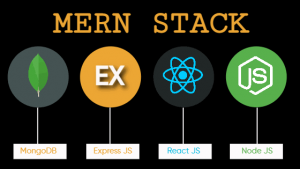The MERN (MongoDB, Express.js, React, Node.js) stack has gained immense popularity in web development due to its versatility and efficiency. To ensure the success of your MERN project, it’s crucial to follow best practices that can improve code quality, maintainability, and scalability. In this blog, we’ll explore some of the key best practices for MERN development.

Project Structure:
Organize your project into a well-defined directory structure.Separate frontend (React) and backend (Node.js) code for clarity.Use a consistent naming convention for files and folders.
Version Control:
Utilize version control systems like Git for tracking changes.Create meaningful commit messages and use branching strategies.
Server-Side Development (Node.js/Express.js):
Implement RESTful API design principles for consistent endpoints.Use middleware for handling common tasks like authentication and validation.Employ environment variables for configuration management.
Database (MongoDB):
Follow data modeling best practices to create efficient schemas.Use indexing to improve query performance.Implement proper error handling for database operations.
Client-Side Development (React):
Break down UI into reusable components for maintainability.Employ state management libraries like Redux or Context API for complex applications.Optimize component rendering to reduce unnecessary re-renders.

Performance Optimization:
Minimize network requests by bundling and code splitting.Implement server-side rendering (SSR) for improved initial load times.Use lazy loading for images and components.
Security:
Sanitize and validate user inputs to prevent SQL injection and XSS attacks.Implement authentication and authorization mechanisms.Regularly update dependencies to patch security vulnerabilities.
Testing:
Write unit tests for both frontend and backend components.Use testing libraries like Jest and Enzyme (for React).Implement end-to-end (E2E) tests for critical workflows.
Error Handling
Set up centralized error logging and monitoring.Handle errors gracefully by providing meaningful error messages to users.Implement error boundaries in React to prevent app crashes.
Deployment and Scalability:
Choose a robust hosting platform like AWS, Heroku, or Vercel.Set up automated CI/CD pipelines for continuous deployment.Monitor application performance and scale resources as needed.
Documentation:
Maintain thorough documentation for your codebase, APIs, and project setup.Use tools like Swagger for API documentation.
Code Reviews:
Conduct regular code reviews to identify and fix issues early.Encourage a culture of code quality and collaboration within your team.
Conclusion:
By adhering to these best practices for MERN stack development, you can build robust, secure, and maintainable web applications. Keep in mind that best practices may evolve over time, so stay updated with the latest trends and continually improve your development processes for optimal results.
Frequently Asked Questions
Q:- What is the MERN stack, and why is it popular?
A:- MERN is a full-stack development framework comprising MongoDB, Express.js, React, and Node.js. It’s popular for its efficiency in building modern web applications.
Q:- How should I structure my MERN project for scalability?
A:- Typically, it’s recommended to use a modular folder structure, separating components, routes, models, and controllers for maintainability.
Q:- What’s the best approach for handling authentication and authorization in a MERN app?
A:- JWT (JSON Web Tokens) authentication is often preferred, coupled with middleware for role-based authorization.
Q:- What are some strategies for optimizing the performance of a MERN application?
A:- Techniques like code splitting, lazy loading, and server-side rendering can help improve performance. Caching and optimizing database queries are also crucial.
Q:- How can I secure my MERN application against common security vulnerabilities?
A:- Sanitize user inputs, use parameterized queries to prevent SQL injection, implement CORS policies, and regularly update dependencies to patch security vulnerabilities.
Q:- What’s the recommended way to handle API requests and state management in a React application within the MERN stack?
A:- Use libraries like Axios or the Fetch API for making API requests and consider state management solutions like Redux or React’s Context API.
Q:- What’s the role of Express.js in a MERN application, and how can I improve its performance?
A:-Express.js serves as the backend framework. To enhance performance, use middleware effectively, optimize routes, and consider using compression and caching.
Q:-Is server-side rendering (SSR) important in a MERN app, and when should I implement it?
A:-SSR can improve SEO and initial load times. Implement it when SEO or performance for first-time visitors is a priority.
Q:-What are some best practices for deploying a MERN app to production?
A:-Set up a reverse proxy (e.g., Nginx), use a process manager (e.g., PM2), enable HTTPS, and monitor your application using tools like New Relic or Prometheus.
Q:-How can I ensure the scalability and availability of my MongoDB database in a MERN stack application?
A:-Consider using a database cluster with sharding and replication, monitor performance, and have a backup and disaster recovery plan in place.
Master Your Coding Skills with BootSelf AI
If you're looking to enhance your coding abilities and upskill in artificial intelligence, look no further than the BootSelf AI app. This innovative platform provides AI-based coding lessons that are tailored to your individual learning pace.
Available on both iOS and Android, you can download the BootSelf AI app and start mastering coding skills today:





